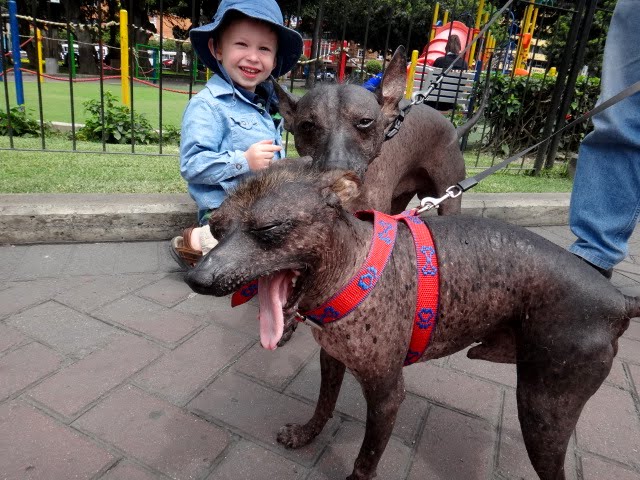So this post is a tad bit late coming, as we went to Lima, Peru more than a year ago, but beggars can't be choosers, and at least I've gotten around to it now.
My company, BNamericas, had an event in Lima focused on energy, and as an old oil writer, I got to go to check out our events and cover the event, too. Because of that, we decided to wrap a little family trip together and stayed over the weekend. It was a quick trip, but I fell in love with Peru in about a minute and a half, and I can't wait to go back!
 |
| Plaza de Armas (or Plaza Mayor) was founded by conquistador Francisco Pizzaro in 1535. |
Let me give you some quick take-aways from Lima, and then we'll get to some of the great spots we discovered. First off, while Santiago is decidedly European, Lima is exactly what you picture when you think of Latin America -- hot, sweaty, amazing foods, lively music spilling from windows and the friendliest people you could ever have the priviledge of meeting.
 |
| Kitties hanging out with the Virgen Mary. |
While Santiago is filled with stray dogs, Lima is filled with stray cats, and they lounge throughout the parks and add a bit of character to the city. Additionally, Peru has an
ancient dog that was the pet of pre-Inca cultures there. While the people seem to be extremely proud of their hairless ancient pets, I have to say, they are quite ugly.
 |
| Trippie doesn't seem bothered by their looks. |
We stayed at this lovely and inexpensive bed and breakfast in the San Isidro district called
Casa Bella B&B. The hotel is boutique (read: just a couple of rooms) and has been transformed from an old mansion. The people there are extremely helpful, the grounds offered a lovely patio garden where we could sit and let Trip play outside, and the location was a great jumping off spot for exploring Lima.
 |
| Ancient Huaca Pucllana pyramids in Miraflores, Lima. |
The capital city of Peru, Lima is on the coast of the Pacific. While Miraflores is one of the most upscale neighborhoods overlooking the waters, this modern city is juxtaposed with ancient relics and pyramids from the native people who lived there centuries ago sprinkled throughout the city.
 |
| Loads of surfers come to the beaches of Lima to take advantage of the gnarly waves. |
One of our favorite discoveries in Lima was the neighborhood of Barranco, which hosts a lovely mix of old buildings, beautiful vistas, bohemian artists, inexpensive B&Bs and lots of bars and restaurants. Founded in 1874, Barranco reminded me of a less commercialized San Antonio River Walk, but exchange the river for the ocean.
 |
| Phaedy and Trip on the Bridge of Sighs in Barranco, famous for granting wishes |
Also, we got to go to the amazing Magic Water Circuit, which is in Reserve Park and a definite must-see. We didn't really know what we were getting into, but had just heard to go, and boy were we in for an amazing surprise. The public park transforms at night with all the fountains showcasing water, lights and music. It was breathtaking to watch lights transform over the fountain into ice skaters dancing and beautiful cultural dances.
 |
| The Troys at the Magic Water Circuit. |
Although it's decidedly touristy, we booked an afternoon on a tour bus that drove us around Lima and stopped at the beautiful
Museo Larco, which houses one of the largest collections of pre-Columbian art in an amazing 18th centrual mansion.
 |
| Museo Larco |
I really enjoyed getting to sit in the open-air double-decker bus and see all sorts of neighborhoods and hear the history while Trip napped, and he woke up just in time for the museum, which also had a lush garden that he enjoyed playing in.
 |
| Not too shabby! The Troys get to see Lima in a couple of hours (and not get lost) |
Truly, you can't talk about Peru and not talk about the food (which is exquisite) and the pisco sours; nonetheless, that is a post for a different day because I could go on an on about the culinary experience that is Peru. So I leave you with a shot of us enjoying a Peruvian pisco sour at Museo Larco, and I definitely will drink to your health!
 |
| ¡Salud! A happy family enjoying pisco sours at Museo Larco in Lima, Peru. |


















